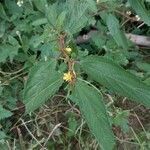Annual herb, suberect or decumbent, up to 1 m tall; stems glabrous to sparsely pilose.. Leaves narrowly ovate, ovate or narrowly oblong, 3–11.5 cm long, 0.6–1(–3) cm wide, margins coarsely serrate, usually with a pair of basal setae 0.6–0.9 mm long, rounded at the base, acute to subacute, glabrous above, pubescent on midrib beneath and occasionally on blade; petioles 0.6–1.4 cm long, pilose especially on upper surface; stipules up to 5 mm, glabrous.. Inflorescences of 1–4-flowered glabrous fascicles; bracts up to 3 mm long, glabrous; peduncles ± 1 mm long; pedicels ± 1 mm long.. Sepals 4–5, 3.5–4.3 mm long, 0.5–0.6 mm wide, glabrous or with odd hairs.. Petals 4–5, 3.5–4.8 mm long, 0.5–1.5 mm wide, obovate, tapering to a short ciliate claw; stamens ± 10; ovary cylindric, 2–3 mm long, papillose.. Capsule a slender cylinder, 2–4 cm long, 1–1.5 mm wide, held erect, straight or slightly curved, splitting into 3 valves, glabrous to sparsely setulose, ending in 3 spreading horns, these usually bifid.. Seeds angular, oblong, dull dark brown, up to 0.5 mm in diameter, finely reticulate.. Fig. 18/13 (fruit, p.103).
Plants herbs, annual. Stems erect to ascending, 3–6 dm, mostly glabrous. Leaves: petiole 5–15(–25) mm; blade oblong-lanceolate to elliptic-obovate, linear-lanceolate, or narrowly elliptic, 1.5–9(–12) cm, base rounded, margins crenate to serrate, each of proximal pair of teeth usually prolonged into caudate-setaceous point 3–5 mm, apex acute to acuminate, surfaces glabrous or sparsely hirsute on veins. Inflorescences solitary flowers or fasciculate or cymose, 2 or 3(or 4)-flowered. Pedicels 0–1 mm. Flowers: sepals linear-oblong to narrowly elliptic or narrowly obovate, 3–5 mm, not awned, glabrous; petals 3–5 mm; stamens 10–15(–20). Capsules cylindric, terete, not wing-angled, 3-valved, each valve terminated by bifurcate awn 1.5–2 mm, 20–40 × 1.5–2 mm, glabrous. 2n = 14.
A tall erect branching herb. It grows to 60 cm tall. It grows each year from seeds. The branches are angular and can have some hairs. The leaves are simple and with teeth along the edge. There are a pair of stiff hairs at the bottom of the leaf and another pair where the leaf joins the stem. The flowers are small and yellow. The fruit are long thin pods. These are divided at the top into 3 short spreading horns.
Leaf-lamina 2·5–11 × 0·6–4·5 cm., oblong to lanceolate, acute at the apex, margin serrate or serrate-crenate, rounded at the base, glabrous or sparsely setulose-pubescent on the nerves; petiole up to 2 cm. long, pilose on the upper side; stipules up to 10 mm. long, setaceous, glabrous.
Capsule up to c. 4 cm. long, held more or less erect, straight or slightly curved, usually somewhat ribbed, sparsely and minutely setulose-scabrid, terminated by 3 spreading horns c. 1 mm. long; valves only shallowly pitted inside to contain the seeds.
Annual herb up to c. 0·6 m. tall, usually erect but with the older branches rather spreading; branchlets at first rather compressed or angular, glabrous or sparsely pilose.
Inflorescences of 1–3-flowered leaf-opposed cymes; peduncles up to 1 mm. long, glabrous; pedicels similar, up to 1 mm. long; bracts 1–2 mm. long, setaceous, glabrous.
Petals yellow, the same length as the sepals, very narrowly oblanceolate, with a basal minutely ciliolate claw c. 0·3 mm. long.
Erect or spreading annual herb, 0.6 m high. Capsule with 3 spreading horns at apex. Flowers yellow.
Sepals c. 5 mm. long, linear, slightly broader in the upper half, bluntly acuminate, glabrous.
Seeds c. 1·4 × 0·8 mm., numerous, dark brown, cylindric or somewhat quadrangular-cylindric.
Androgynophore almost obsolete, but annulus visible and clasping the base of the ovary.
Ovary trigonously cylindric, papillose, 3-locular; style c. 2 mm. long, glabrous.
A weed of cultivation
Flowers yellow.
Stamens 8–10.

